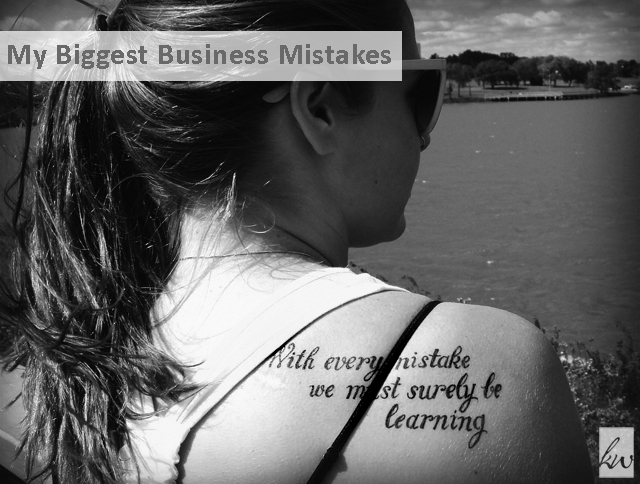After my business success series wrapped last week, you might have been wondering if everything was super easy or if I’ve made mistakes in my business. Of course I’ve made my fair share of mistakes! Everyone does. Here are some of my biggest business mistakes to date (or as I like to think of them, my learnings and growth opportunities):
Spending a crapload on marketing and promotions when I first relocated to California. How much is a crapload? About $20k, distributed across:
- advertising via print and online publications,
- participating in a bridal show,
- joining networking groups and attending related events,
- printing promotional materials and product samples,
- sending clients gifts, and
- managing my website and SEO.
As you can see, I was taking a bit of a scattershot approach to test outlets and opportunities. So, why was that a mistake? Well, first, it wasn’t strategic. I tested too many things and didn’t set a clear budget to limit my spending. Second, and this I could have only found out through testing, most of those outlets didn’t generate adequate returns to justify the expense. For example, traditional advertising didn’t work as well in California as it had in Virginia.
- In 2007, one ad I placed in a local wedding magazine resulted in 24 inquiries, which converted into 11 bookings.
- That same year, my online Knot ad generated 52 inquiries, resulting in 5 bookings.
Both of those outlets yielded strong responses and, in the case of the print ad, an excellent conversion rate.
- One year later, in California, my combined web/print ad with the Knot yielded 18 inquiries and 3 bookings.
While my hit rate was higher with the Knot in 2008, my referrals were down in the bigger market.
Had I approached marketing and promotions more strategically and incrementally, I could have limited overall expense and made minor tweaks to increase effectiveness throughout the course of the year.

Photo credit: Grace Kifer. CC license by-nc-2.0.
Taking gigs I didn’t want. All of us get inquiries that don’t sit right. Maybe the prospect seems to only care about price or they ask you to do something that isn’t really your specialty. I’m not talking about the gigs where you think everything is fine and then somehow you end up on a different page than your client—because I’ve had those too—here, I’m talking about the gigs where you have an inkling that something’s wrong or see a mental caution flag or even a bright red expulsion card…and still you accept the job.
Well, when I first moved to California, I did exactly that—because I wasn’t sure I could fill my client roster otherwise. Back in Virginia, when my wedding calendar filled up in the first quarter, it was easy to suggest another photographer when someone asked if I could change my style or cut my rates just for them. That’s not always easy when your pipeline is feeling a bit thin.
But here’s what I learned: Every time I took a gig I didn’t want, I regretted it. Either the client and I didn’t exactly mesh, or I ended up having to shoot in a way that felt unnatural or that exhausted me. 50 group formals, anyone?! Yeah, totally not my style. Along the same lines, a related mistake was…
Accepting less than I was worth. I’m not a natural negotiator. I don’t ask other people to cut their rates for me and I’m always thrown when people ask me to do so. However, many engaged couples seem to feel completely comfortable negotiating for cut-rate packages, particularly in the off-season.
At times, when someone’s event hasn’t fit my packages—like when they’re having a small city hall ceremony and need only an hour or two of wedding coverage—I’ve happily crafted a custom package for them. Doing this generally works out fine.
My mistake has been in cutting rates just because someone asks. Whenever I’ve given someone a cut-rate deal, I’ve ended up resenting the client. I know it’s not their fault I cut my rates—it’s totally mine!—I still end up resenting them and that does not a positive client relationship make.
My key takeaway here is that when I’ve offered “deals,” I’ve done it out of fear. When I craft a custom package for a legitimate reason, it’s from the perspective of providing better service to a client. Fear is a bad place from which to act as a business owner.
Listening to other photographers’ wisdom and following industry advice. Shoulds, must-dos, best practices, none of these has served me particularly well in business. As I mentioned in my business success series, trusting my intuition always worked out best.
But I didn’t always heed my intuition. Early in my photography career, a photographer-friend told me that my portrait style wasn’t going to attract clients and, despite all evidence to the contrary, I listened. Had I stayed the path—shooting in my natural rhythm and attracting clients who wanted a relaxed, documentary style—I would probably still be shooting today. Instead, I burned out.
A recent Inc. article helped me clarify exactly what happened. Dr. Shelley Prevost wrote:
My favorite definition of burnout is this: burnout is not about giving too much of yourself, it’s about trying to give what you do not possess.
Exactly! I tried to give what I do not possess.
There are times when you’re struggling and actually appreciate the advice (or maybe just the nonjudgmental ear) of someone else in your field. But, for all those other times when you’re doing ok, I hereby give you permission to ignore everyone else’s opinions and advice and listen instead to your own heart, gut, and mind. Not that you need my permission but, just in case you do, there you have it.
What have your biggest business mistakes been, and what did you learn from them?
Cheers,

















bettie - Yes. Yes. and Yes.